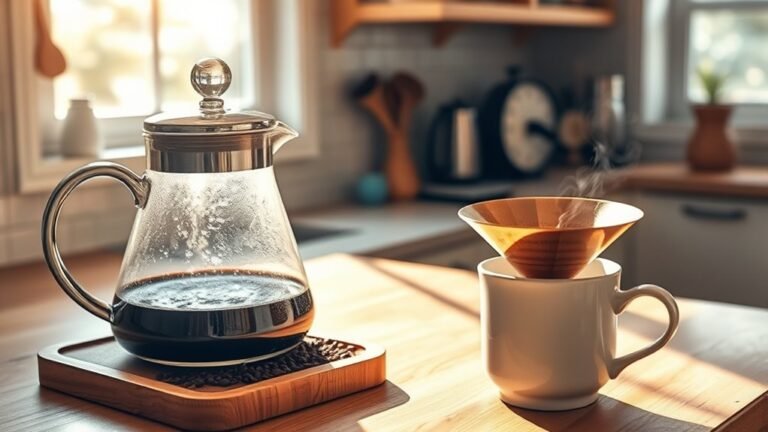Can You Use Regular Coffee for Espresso
You can technically use regular coffee in an espresso machine, but it often leads to disappointing results. Espresso demands specific beans and fine grind sizes for ideal flavor extraction. Using coarser coffee can cause under-extraction, resulting in a weak, watery brew. The pressure required for espresso may not work well with regular coffee, potentially losing rich flavors and aromas. If you explore further, you’ll uncover tips for achieving a more satisfying coffee experience that rivals traditional espresso.
Understanding the Basics of Coffee and Espresso
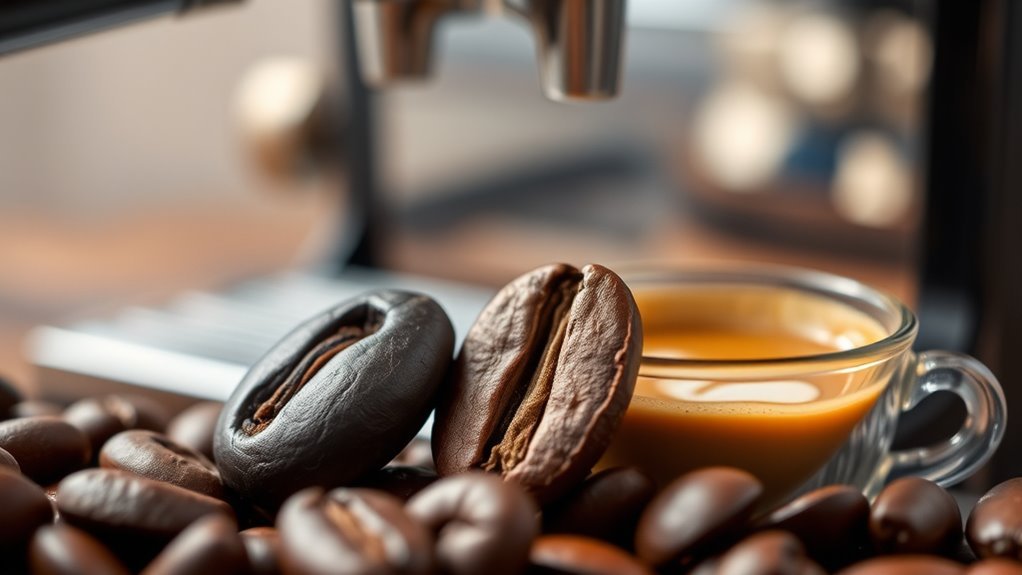
While many people enjoy coffee in its various forms, understanding the distinct characteristics of coffee and espresso is essential for appreciating their unique qualities. Coffee extraction plays a vital role in this distinction; it’s not just about brewing time, but also the pressure and fine grind needed for a rich espresso shot. Many espresso myths suggest that any coffee can serve as espresso, but that’s far from the truth. The beans, roast level, and grind size must align for that intense flavor and crema you crave. When you grasp these fundamentals, you’ll appreciate the artistry behind each sip, allowing you to explore the freedom of flavor and the nuances that separate your morning brew from that perfect espresso experience.
The Brewing Process: How Espresso Differs From Regular Coffee
Understanding the distinct characteristics of coffee and espresso sets the stage for appreciating the brewing process that defines them. Espresso extraction techniques rely on high brewing pressure differences, typically around 9 bars, which force hot water through finely-ground coffee. This process creates a rich, concentrated shot, with a thick crema that regular coffee simply can’t replicate. In contrast, regular coffee uses lower brewing pressures and coarser grounds, resulting in a more diluted flavor profile. The extraction time also varies considerably; espresso brews in about 25-30 seconds, whereas regular coffee can take several minutes. This contrast in techniques and pressure not only affects taste but also impacts the overall experience, inviting you to savor each unique cup.
The Role of Coffee Beans in Espresso Production

When it comes to crafting the perfect espresso, the type of coffee beans you choose plays a vital role in determining flavor and richness. Different bean varieties bring unique profiles, while the roast level can either amplify or diminish those characteristics. Understanding these elements can elevate your espresso experience from ordinary to extraordinary.
Bean Types Matter
Although you might think any coffee bean could serve for espresso, the type of beans you choose plays a significant role in determining the flavor, aroma, and overall quality of your brew. The debate of Arabica vs Robusta is essential here, as each bean offers unique flavor intensity.
| Bean Type | Flavor Profile |
|---|---|
| Arabica | Sweet, fruity, complex |
| Robusta | Bold, earthy, bitter |
| Arabica | Higher acidity |
| Robusta | Higher caffeine content |
| Arabica | Softer mouthfeel |
Choosing the right bean can elevate your espresso experience, transforming it from a simple caffeine fix to a rich, sensory journey. So, embrace the freedom to explore these beans and discover your perfect cup!
Roast Level Impact
The roast level of your coffee beans greatly influences the flavor and aroma of your espresso, shaping the very essence of each cup. Dark roasts offer robust flavor intensity, often bringing out notes of chocolate and caramel, providing a rich, bold experience. Conversely, medium roasts strike a balance, showcasing a blend of sweetness and acidity, while lighter roasts can present brighter, fruitier flavors that awaken your palate. Each roast level adds a unique character to your espresso, inviting you to explore various taste profiles. When choosing beans, think about how you want your espresso to resonate with your senses. Embrace the freedom to experiment with different roast levels, and discover the perfect harmony that matches your coffee passion.
Grind Size: Why It Matters for Espresso
Grind size plays an essential role in the art of crafting a perfect espresso, acting as the key that releases the coffee’s full flavor potential. You see, achieving grind consistency is crucial; uneven particles can lead to uneven extraction. If your grind is too coarse, the water flows too quickly, resulting in weak flavors. Conversely, a grind that’s too fine can choke the espresso machine, causing bitter notes to dominate. The ideal extraction time, typically around 25-30 seconds, hinges on this delicate balance. When you master grind size, you enable the freedom to explore the rich nuances in your espresso, transforming a simple cup into an exhilarating journey of taste. So, take the time to get it right; your palate will thank you.
Flavor Profiles: Comparing Regular Coffee and Espresso
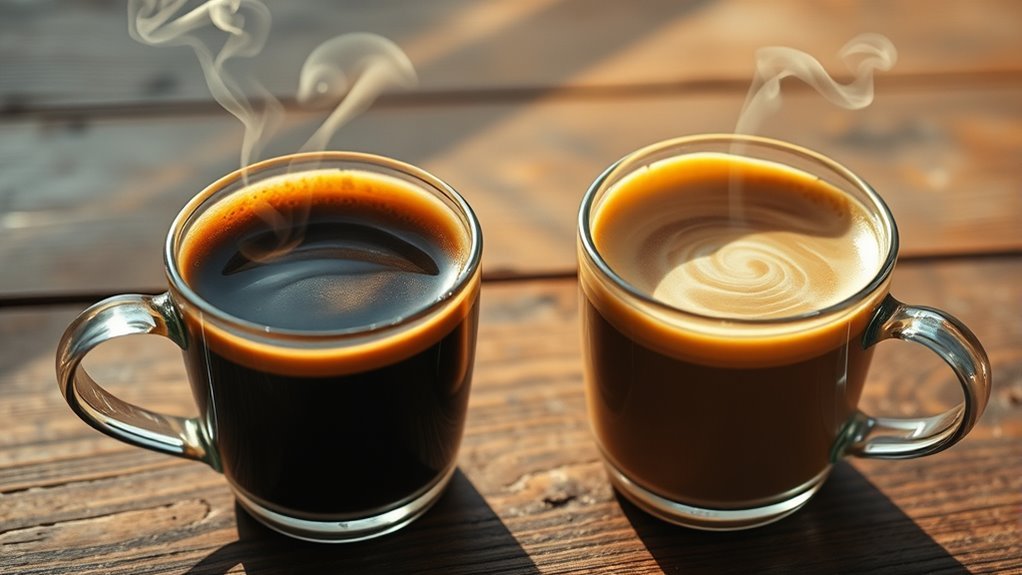
When you taste regular coffee versus espresso, you’re experiencing two distinct domains shaped by bean types and brewing methods. Regular coffee often highlights a broader range of flavors, while espresso delivers a concentrated burst that intensifies sweetness and acidity. Understanding these differences can elevate your appreciation for both styles and guide your choices in the coffee domain.
Coffee Bean Types
Flavor profiles in coffee are as varied as the beans themselves, with regular coffee and espresso offering distinct experiences. The beauty lies in the coffee bean varieties, which create a spectrum of flavors. When considering these beans, think about:
- Arabica: Often sweeter and more complex, perfect for specialty beans lovers.
- Robusta: Bold and earthy, providing a stronger, bitter punch ideal for espresso.
- Liberica: Rare but unique, with fruity and floral notes that can surprise your palate.
Each type brings its own character, influencing how your coffee tastes. Specialty beans elevate the experience, allowing you the freedom to explore and appreciate the nuances of flavor. So, immerse yourself in the world of beans and discover what resonates with your taste buds!
Brewing Methods Impact
While the choice of coffee beans lays the foundation for your brew, the brewing method itself plays an essential role in shaping the final flavor profile. Different brewing techniques can drastically alter flavor extraction, resulting in distinct experiences.
| Brewing Method | Flavor Profile |
|---|---|
| Espresso | Bold, concentrated |
| Pour Over | Bright, clean |
| French Press | Rich, full-bodied |
| Aeropress | Smooth, nuanced |
| Cold Brew | Sweet, mellow |
When using regular coffee for espresso, you may miss the complex richness typical of traditional espresso. Understanding how these brewing methods impact flavor helps you appreciate the nuances each cup can bring, allowing for a more liberated exploration of your coffee journey.
Can Regular Coffee Be Used in an Espresso Machine?
Can you really use regular coffee in an espresso machine? While it’s possible, the results might not meet your expectations. Espresso machine compatibility is key here, as not all machines can handle the grind size and density of regular coffee. You’ll notice significant coffee extraction differences that can affect flavor and consistency. Here are three points to weigh:
Using regular coffee in an espresso machine is possible, but may compromise flavor and extraction quality.
- Grind Size: Regular coffee is usually coarser, which can lead to under-extraction.
- Pressure: Espresso machines rely on high pressure, and regular coffee might not withstand it well.
- Flavor Profile: The richness and intensity of true espresso could be lost.
If you’re searching for that authentic espresso experience, sticking to espresso-specific coffee is your best bet.
Potential Issues With Using Regular Coffee for Espresso
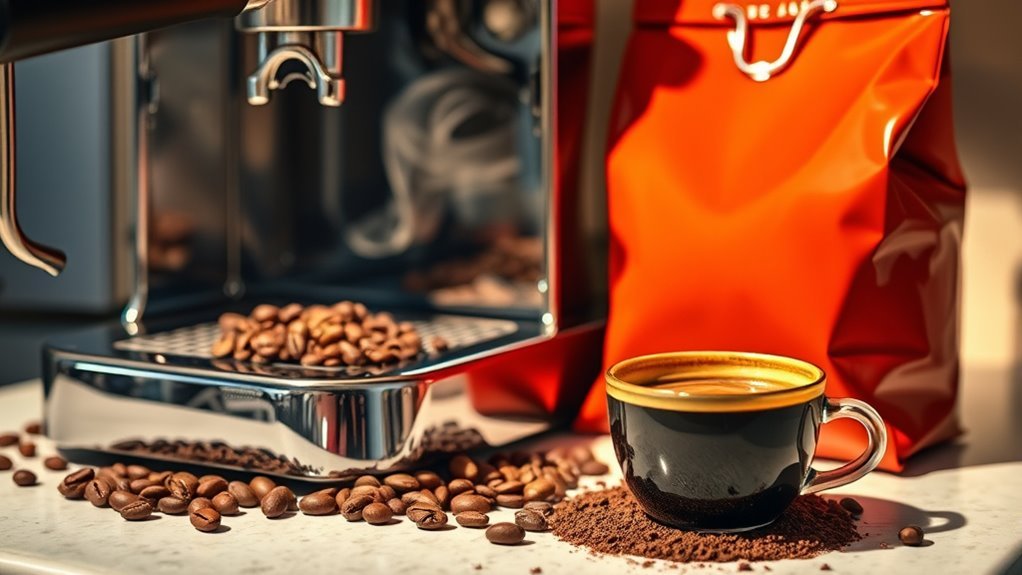
Using regular coffee for espresso might seem like a convenient option, but several potential issues can arise that hinder the overall experience. You may face challenges with brewing consistency and extraction time, leading to a lackluster cup that fails to deliver the rich, bold flavors you crave.
| Issue | Impact on Espresso |
|---|---|
| Inconsistent grind | Uneven extraction |
| Incorrect roast type | Off-flavors |
| Poorly adjusted grind | Bitter or sour notes |
| Inadequate pressure | Weak, watery texture |
| Uncontrolled brewing | Loss of aroma and body |
Ultimately, using regular coffee can compromise the essence of espresso, making it a less fulfilling choice for those passionate about quality in their cup.
Tips for Making Espresso-Like Coffee at Home
If you’re determined to replicate the rich experience of espresso at home without investing in an espresso machine, there are ways to achieve a similar flavor profile and intensity. First, choose a dark roast coffee; it enhances the depth and complexity of flavor. Second, grind your coffee finely, as this maximizes coffee extraction, allowing for that bold taste. Finally, brew using a method that applies pressure, like a French press or AeroPress, to mimic espresso’s signature richness.
Beware of espresso myths—while you won’t get the exact experience, you can create a satisfying alternative. Embrace your freedom to explore and experiment, and soon you’ll revel in your homemade espresso-like creations.
Alternatives to Traditional Espresso
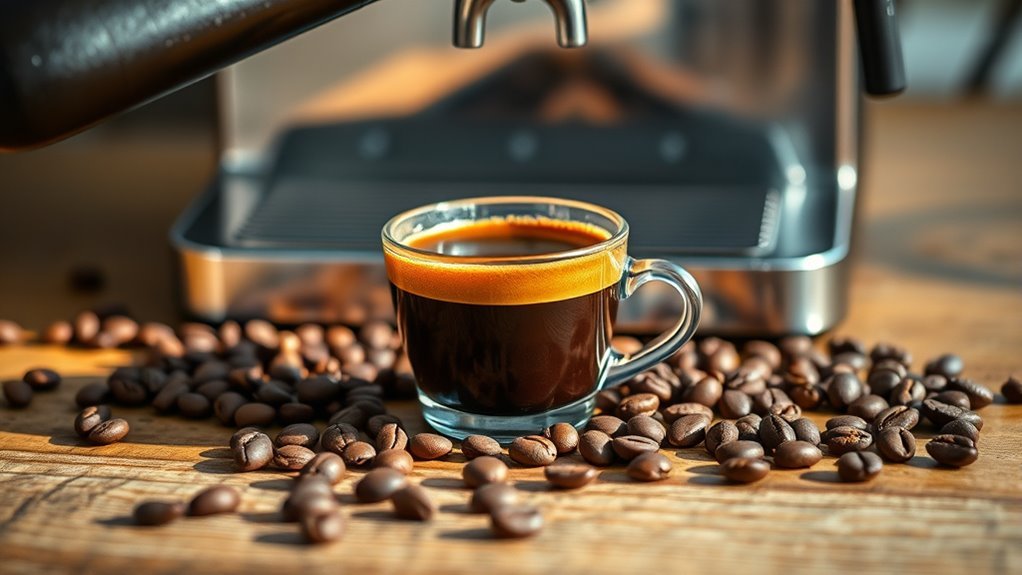
When seeking alternatives to traditional espresso, you’ll find that the type of coffee bean you choose plays a vital role in flavor and extraction. Exploring different brewing methods can also open up new dimensions for your coffee experience, offering rich profiles that rival classic espresso. By understanding these elements, you can craft a satisfying cup that aligns with your personal taste.
Coffee Bean Types
Exploring the world of coffee bean types reveals a rich tapestry of flavors and aromas that can serve as compelling alternatives to traditional espresso. If you’re looking to break free from the conventional, consider these coffee bean varieties, each with unique origins and profiles:
- Arabica: Known for its smooth, sweet taste, it’s often grown at higher altitudes, bringing out complex flavors.
- Robusta: With a bolder, more bitter profile, this bean thrives in warmer climates, offering a higher caffeine content.
- Liberica: A rare find, this bean presents a floral, fruity aroma, making it an adventurous choice for those seeking something different.
Brewing Methods Comparison
While the choice of coffee bean types can greatly influence your brew, the method you use to extract flavors is equally important. Exploring alternative brewing techniques can open up new dimensions in your coffee experience. Consider using a Moka pot; it delivers a rich and robust flavor reminiscent of espresso but with a unique twist. Aeropress is another fantastic option, allowing for precise control over coffee extraction and a smooth finish. If you’re seeking convenience, French press can produce a bold cup, albeit without the intensity of traditional espresso. Each method offers distinct characteristics, empowering you to express your coffee freedom. Embrace experimentation and discover how different brewing techniques elevate your daily ritual beyond mere caffeine consumption.
Final Thoughts on Coffee Choices and Preferences
Although the debate surrounding coffee choices can be polarizing, it ultimately boils down to personal preference and individual taste. Your coffee preferences define your unique experience, and that freedom is what makes this journey delightful. When deciding on espresso choices, consider these factors:
- Flavor Profile: Different beans yield distinct tastes; explore to find what resonates with you.
- Brewing Method: Each technique reveals various nuances; experiment to discover your ideal brew.
- Strength and Body: Determine how bold you want your cup; this will guide your selection.
Embrace the vast diversity in coffee. Whether you lean toward traditional espresso or enjoy regular coffee, the choice is yours. Your palate deserves the liberty to explore and savor every sip!
Frequently Asked Questions
Can I Brew Espresso With Pre-Ground Coffee?
You can brew espresso with pre-ground coffee, but it’s important to take into account grind size and brewing techniques. Pre-ground coffee often varies in coarseness, which can affect extraction. For espresso, a fine grind is vital, allowing for the best flavor and crema. If you’re using pre-ground coffee, make sure it’s specifically labeled for espresso. While it may limit your options, experimenting with different brands can lead you to discover a blend that satisfies your taste buds.
What Coffee Types Are Best for Espresso?
When choosing coffee for espresso, you’ll want to explore various espresso bean types. Typically, blends of Arabica and Robusta create a rich flavor profile. For roast levels, medium to dark roasts are ideal, as they yield the bold, intense flavors espresso lovers crave. Don’t shy away from experimenting with different origins and roast variations; the freedom to explore unique tasting notes can elevate your espresso experience to new heights!
Does Espresso Have More Caffeine Than Regular Coffee?
When you think of espresso, it’s like a caffeine rocket, blasting you into a world of energy! But when you plunge into the espresso caffeine comparison, you’ll find that a shot packs a punch, but a regular cup of coffee often has more caffeine overall due to the brewing methods. So, while espresso delivers a quick burst, your morning brew might just keep you soaring longer throughout the day!
Can I Use Flavored Coffee for Espresso?
You can definitely use flavored beans for espresso, but it’s a creative gamble. The espresso taste can be transformed dramatically, enhancing or overwhelming traditional flavors. If you love experimenting, flavored coffee can deliver unique notes, but be cautious—it may mask the rich, bold essence you crave. Balancing those flavors is key. Embrace the freedom to explore new dimensions, but remember, not all flavored beans will yield the robust shot you desire.
How Long Can I Store Espresso Beans?
You might be surprised to learn that freshly roasted espresso beans can lose up to 60% of their flavor within just two weeks if not stored properly. To maintain ideal espresso storage, keep your beans in an airtight container in a cool, dark place. Aim to use them within two to four weeks for the best flavor experience. Remember, preserving bean freshness is key to enjoying that rich, bold espresso you love!

